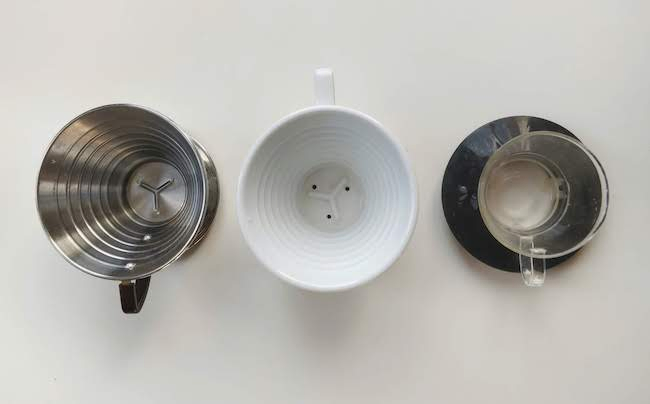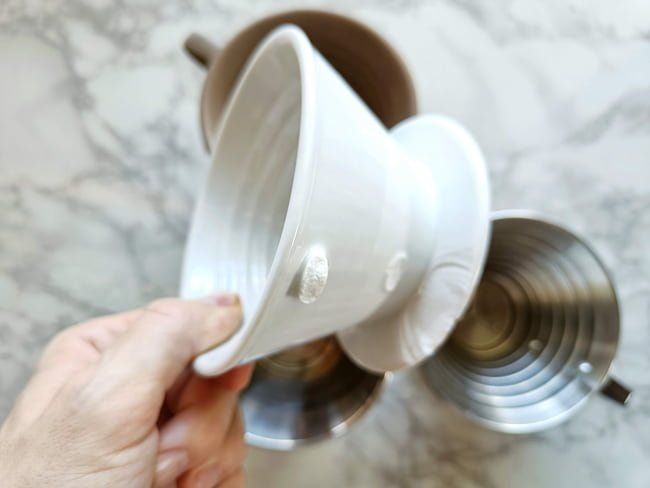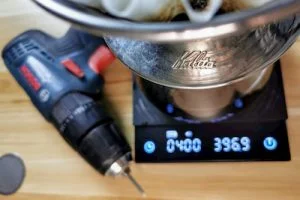Over the years I have tried and tested all the different Kalita Wave models.
Even though these drippers have the same name, and in theory should be brewing identically that’s not really the case.
Call it bad quality control or quirky charm; that’s up to you 🤷♂️
I personally really like a few of the Kalita Waves, but other ones I wouldn’t recommend.
In this review, I’ll zoom in on all the small details that are important when it comes to picking a model that’s right for you.
In case, you’re in a hurry, you can find the tl,dr version below:
The Best Kalita Wave Model – According to The Coffee Chronicler
- Ceramic Kalita Wave: 4.7/5
The best combination of consistency, sturdiness, flavor and price. - Tsubame Steel: 4.5/5
If money is no object, then the steel Tsubame is an excellent option. More sturdy than the ceramic version and with less thermal management required. Only downside is the steep price. - Sandstone / Sagan: 4.2/5
The Sagan models can vary in flow rate from batch to batch. The material is a bit polarising. Either you love it or hate it. - Glass: 4.0/5
Works very well, but also incredibly fragile. - Stainless Steel: 2.5/5
Drains slowly and clogs very easily due to design errors. Even though it’s very widespread, I wouldn’t recommend it.
* The small version (155) seems less prone to clogging compared to the big 185 model
| Preview | Product | Rating | |
|---|---|---|---|

|
Kalita Wave series 185 Lotto... | ||

|
Carita WDS-185 Stainless Steel... | ||

|
Kalita Wave Dripper 155 series... | ||
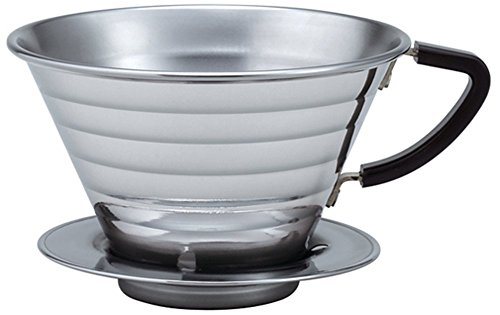
|
Kalita Wave 185 Drippers |
Kalita Wave: Backstory
In specialty coffee, we admire consistency and almost scientific accuracy. Stuff like this is often heard among the most hardcore geeks:
The extraction yield should be ‘X,’ and total brew time ‘Y.’
However, often we fail to question some of the most basic assumptions.
Recently, I have been experimenting more with the Kalita Wave. I have had the small glass version for a few years and always liked it even though I was more into the Hario V60.
Since I wanted to brew larger batches, I got myself the iconic stainless steel Kalita Wave 185.
However, I experienced something quite odd: The steel version seemed to percolate a lot slower and more unpredictable than my usual glass model.
Kalita Wave Flow Rate
Puzzled, I conducted a simple experiment to see whether there was any actual difference between the two.
- I poured 500 ml (16,90 fl oz) of water in each dripper
- Then I measured how fast it would drain.
I was quite astounded: The small glass version drained 83 percent faster than the metal version.
I then got my hands on the 185 Wave in ceramic and did the same experiment. Once, again I was surprised; this brewer also acted differently, however not quite as dramatically.
By now I was convinced that all Kalita Waves had their own personality and flow rate. The only thing they seemingly had in common was the name.
I reached out to some of my good coffee buddies on Instagram (thank you, guys!) and asked them to perform the same experiment with their versions of the Kalita Wave.
More water pouring ensued, and eventually they got back to me with additional data to confirm my hypothesis: Not all Waves are the same!
Check out the infographic below to see the results of the experiment!
Pour over Implications?
The above measurements don’t say anything about which model is brewing better coffee. All it is saying is that the Kalita Waves are somewhat different.
Notably, the stainless steel model is an outlier. It’s almost double as slow compared to the Glass 185 Wave.
A skilled barista would probably be able to overcome these differences by adjusting grind size and pour speed; however, it’s problematic when Kalita Wave recipes are shared as if there’s only a standard model.
The skeptical reader might say that pouring water into an empty cone doesn’t prove anything, so to counter that argument I did the same experiment with a pre-wet filter in the dripper. Again, the results were starkly different.
With pre-rinsed filter
- Tsubame 185 – 50 sec.
- Glass 155 – 56 sec.
- Ceramic 185 – 62 sec.
- Stainless steel 185 – 92 sec.
Clogging Kalita Wave 185 vs 155?
My personal experience brewing with these different models aligned nicely with the test results. The stainless steel version is a lot slower than its siblings.
In addition, both I and other homebrewers have noticed that it tends to have clogging issues. This happens when the combined weight of water plus saturated coffee grounds pull the paper filter down so it covers one or more of the drain holes. This is especially prone to happen if you follow a multi-stage pouring recipe (i.e. more than 2-3 pours).
I questioned my coffee geek friends about this, and the general opinion was that the stainless steel version had this issue, while the glass and ceramic ones were unlikely to get clogged.
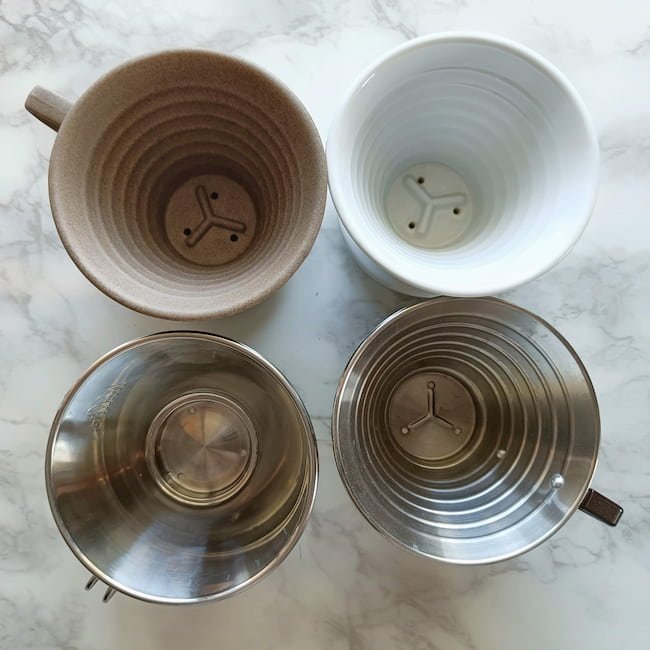
Differences between Kalita Wave models
Let’s take a closer look at the design of each model, and talk about pros and cons.
Ceramic Kalita Wave
The ceramic version has three protruding ribs meant to raise the bottom of the filter. These ribs are protruding far enough that you don’t have to worry about the filter getting dragged down to the weight of the slurry. Also, the holes are placed to the side of the ribs, which makes it even more difficult for clogging to happen.
Overall, the ceramic has an excellent flow rate and consistency.
The design is nice without being the most eye catching among the Kalita Waves.
The main downside is of course that ceramic is more fragile than other materials.
Glass Kalita Wave
The glass model looks completely different from the ceramic version. Yes, it’s also a flat-bottom dripper but that’s where similarities end.
Instead of ribs in the bottom, the glass has a center that is lifted. This efficiently keeps the filter away from the drain holes.
The glass Kalita has a very fast flow rate and it’s predictable. It’s a pleasure to brew on.
However, the glass version is rather fragile, so if you’re the least bit clumsy, I would avoid that model.
Leading up to this experiment, I bought the bigger glass version but broke it after only two days of use.
The 155 glass version should be more sturdy since its plastic cap protects it better and it has a better weight distribution. On both versions, the plastic caps are of identical size. However, the 185 is much larger so technically it’s a lot more exposed. To back up my point, I’ll add that I have had the 155 glass version for about 2,5 years, without any accidents so far (knock on wood).
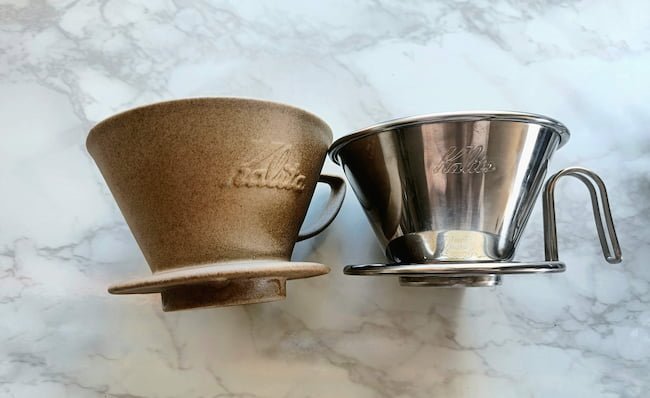
Stainless Steel (SS) Kalita Wave
The stainless steel model looks great when you see it on the brew bar. However, it has a poor design around the drain holes. Like the ceramic and sandstone versions, it also relies on ribs to keep the filter from blocking the drain holes.
However, it does a poor job of this. The ribs are very shallow, and the placement of the holes is not ideal. This make clogging and stalling very common with the steel Kalita Wave.
For that reason, many people who use this brewer, have to resort to special techniques, such a pouring all water in one or two goes.
Tsubame Kalita Wave (steel/copper)
I must admit I was hesitant to invest in the Tsubame Kalita Wave 185. I feared that it would an expensive but inferior product, but luckily my doubts were unjustified.
The Tsubame is similar to the glass version, in the sense that it doesn’t have ribs. However, the bottom is less convex.
It’s works more or less like the glass version, but without the fragility. If you can afford it, this version is excellent! It has a fast flow rate comparable to the ceramic and glass versions, and stalling is not likely to occur.
I have already dropped and ruined both the glass and ceramic drippers. As they say; buy once, cry once. I expect the steel Tsubame to outlast all the other Kalitas in my collection.
Btw, the handle on the Tsubame version might look flimsy on pictures. But when you see it in real life, you’ll realize that it’s secured in a very study and elegant fashion. The Tsubame just oozes luxury. It’s expensive, but if you can afford it, I think you’ll appreciate it.
I chose the steel version, because I like that color a bit more than the copper version, and the price is also a bit lower.
Conclusion: Kalita Wave Dripper Review
If you’re interested in brewing with a Kalita Wave, I’d suggest going for one that drains rather fast and doesn’t have the clogging issue.
Sturdiness should also be a consideration.
The ceramic version will be susceptible to breaking if you drop it from a distance, but unless you’re clumsy (like me) it will probably be fine for daily use. It has some heft, so you’re not likely to push it over by accident.
With all these considerations, I think the ceramic Kalita Wave offers the best combination of usability and longevity. The only downside is the weight; at 317/365 grams (11-13 oz), it’s not exactly ideal for travel.
The more expensive Tsubame version, offers many of the same benefits as the ceramic version. However, it’s a lot lighter and also more likely to survive being dropped. That model would be my upgrade choice if money is no object.
Modding/Hacking the Stainless Steel Kalita
I have recently experimented with “modding” the stainless steel Kalita Wave.
There are two small hacks that will improve the performance of this model.
The easiest one is to use the steel dispersion screen from the Flair Espresso Pro 2 in the bottom of the dripper. This will help to prevent any clogging or stalling. However, the downside is that you have to pay attention to an extra moving part. And if you don’t already have the dispersion screen, you will have to spend $12.
The second hack is to enlarge the drain holes on the dripper. If you have a drill at home and a cobalt drill bit that is around 4 mm, this is a relatively easy hack to perform.
You can check out the video on my YouTube channel to learn more about this little trick.
I took the Kalita from a drain time of 55 seconds to 29 seconds by making the holes sligthly larger. This hack will not eradicate the problem where the filter will cling to one or more drain holes, however, it will improve the performance and make the steel version more similar to the other Kalita models in terms of flow rate.
Curious about how I brew the Kalita? Check out this video:
- Update 25th August 2019: Kalita has recently released a sandstone version named ‘Sagan’. The dripper is made in collaboration with the craftsmen from the Hasami town, who also created the ceramic dripper. It performs similarly to the ceramic version and has many of the same pros & cons.
- Update 2021: I finally bought a Kalita Sagan, and this version has a flow rate similar to the glass-version. Actually, I think this is slightly too fast. My conclusion is that the Sagan drippers have consistency issues, and that ceramic is a better choice.
FAQ
I think the ceramic 185 model makes sense to get for most people. However, your case might be special, so I suggest that you click the article to read the full explanation.
I suggest that you get the big size (185). This size works well even with doses down to 15 grams.
The small 155 Kalita Wave only works for rather small doses. Around 18 grams seems to be the maximum.
The Kalita Wave is not better per se, but many experienced baristas prefer the flavor clarity of flat-bottom drippers. If you’re into light roasts you might enjoy the Kalita Wave a lot.
